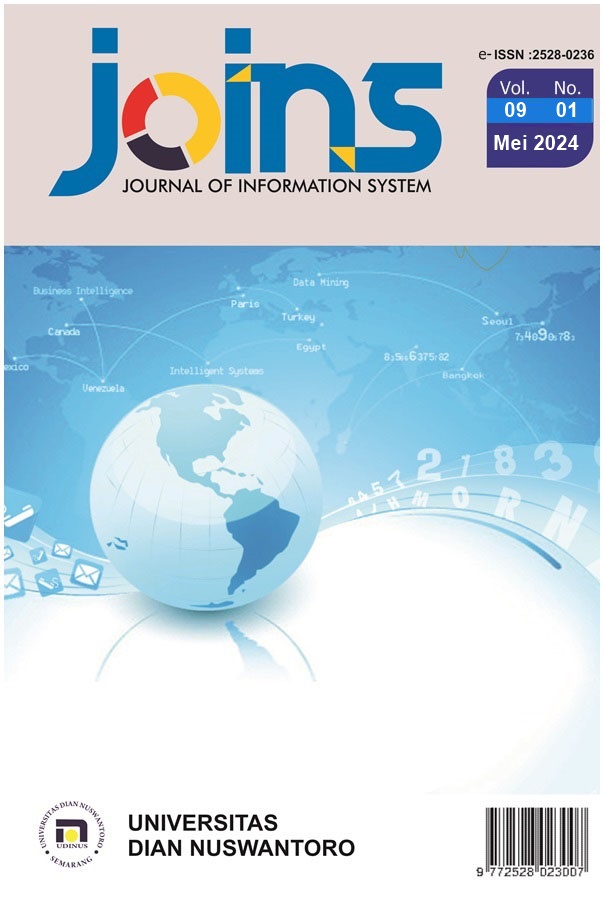Perbandingan Algoritma AES128 dengan SHA256 dalam Kecepatan Enkripsi Pengiriman Data
DOI:
https://doi.org/10.33633/joins.v9i1.8800Abstract
Internet of Things bekerja untuk menyediakan berbagai layanan yang menghubungkan sensor dengan aktuator. Pada masa sekarang, layanan IoT telah banyak digunakan diberbagai bidang. Dengan pertumbuhan eksponensial IoT menyebabkan meningkatnya masalah ancaman keamanan. Untuk memastikan keamanan data tersebut, diperlukan algoritma untuk mengenkripsi data. Algoritma yang paling umum dalam melakukan enkripsi adalah Advanced Encryption Standard (AES). AES adalah salah satu metode yang digunakan untuk mencapai privasi dan kerahasiaan data yang ditransfer melalui berbagai jaringan komputer. Selain AES, terdapat pula SHA256 sebagai algoritma enkripsi. Dalam implementasinya algoritma SHA256 digunakan untuk integritas data dan otentikasi pesan. Metode yang digunakan dalam meneliti perbandingan enkripsi menggunakan algoritma AES (Advanced Encryption Standard) dengan SHA-256 (Secure Hash Algorithm 256-bit), dapat mengadopsi model NDLC (Network Development Life Cycle). Baik AES maupun SHA-256 adalah algoritma yang kuat dan mapan untuk enkripsi data, dan kecepatan keduanya hampir sama dengan perbedaan yang kecil dalam ukuran milisekon.References
N. R. A. Abosata, A. H. Kemp, and M. Razavi, “Secure Smart-Home Application Based on IoT- CoAP protocol,” 2019 Sixth Int. Conf. Internet Things Syst. Manag. Secur., pp. 13–17, 2020.
F. Z. Hamza, S. EL Aidi, A. Bajit, S. Beloualid, H. Chaoui, and A. Tamtaoui, “Advanced IoT Network Topologies to Optimize Medical Monitoring Platforms based on a Constrained and Secured IOT Application Protocol CoAP,” E3S Web Conf., vol. 351, pp. 3–7, 2022, doi: 10.1051/e3sconf/202235101011.
M. El-hajj, H. Mousawi, and A. Fadlallah, “Analysis of Lightweight Cryptographic Algorithms on IoT Hardware Platform †,” Futur. Internet, vol. 15, no. 2, pp. 1–5, 2023, doi: 10.3390/fi15020054.
N. Kheshaifaty and A. Gutub, “Engineering Graphical Captcha and AES Crypto Hash Functions for Secure Online Authentication,” J. Eng. Res., 2021, doi: 10.36909/jer.13761.
A. R. Chowdhury, J. Mahmud, A. R. M. Kamal, and M. A. Hamid, “MAES: Modified advanced encryption standard for resource constraint environments,” 2018 IEEE Sensors Appl. Symp. SAS 2018 - Proc., vol. 2018-Janua, pp. 1–6, 2018, doi: 10.1109/SAS.2018.8336747.
Y. Liu et al., “Design of password encryption model based on AES algorithm,” Proc. 2019 IEEE 1st Int. Conf. Civ. Aviat. Saf. Inf. Technol. ICCASIT 2019, pp. 385–389, 2019, doi: 10.1109/ICCASIT48058.2019.8973003.
B. Barani Sundaram, M. K. Mishra, D. Thirumoorthy, U. Rastogi, and B. Pattanaik, “ZHLS Security Enhancement by integrating SHA256, AES, DH in MANETS,” J. Phys. Conf. Ser., vol. 1964, no. 4, 2021, doi: 10.1088/1742-6596/1964/4/042003.
M. Husni et al., “Security audit in cloud-based server by using encrypted data AES -256 and SHA-256,” IOP Conf. Ser. Mater. Sci. Eng., vol. 830, no. 3, 2020, doi: 10.1088/1757-899X/830/3/032015.
H. Blankson and R. Chattamvelli, “A Symmetric Scheme for Securing Data in Cyber-Physical Systems/IoT Sensor-based Systems based on AES and SHA256,” Int. J. Comput. Appl., vol. 184, no. 24, pp. 12–17, 2022, doi: 10.5120/ijca2022922278.
N. Naik, “Choice of effective messaging protocols for IoT systems: MQTT, CoAP, AMQP and HTTP,” 2017 IEEE Int. Symp. Syst. Eng. ISSE 2017 - Proc., 2017, doi: 10.1109/SysEng.2017.8088251.
J. Dizdarevi?, F. Carpio, A. Jukan, and X. Masip-Bruin, “A survey of communication protocols for internet of things and related challenges of fog and cloud computing integration,” ACM Comput. Surv., vol. 51, no. 6, pp. 1–29, 2019, doi: 10.1145/3292674.
F. Naim, R. R. Saedudin, and U. Y. K. S. Hediyanto, “Analysis of Wireless and Cable Network Quality-of-Service Performance At Telkom University Landmark Tower Using Network Development Life Cycle (Ndlc) Method,” JIPI (Jurnal Ilm. Penelit. dan Pembelajaran Inform., vol. 7, no. 4, pp. 1033–1044, 2022, doi: 10.29100/jipi.v7i4.3192.
T. Sanjaya and D. Setiyadi, “1-10 Teknik Informatika; STMIK Bina Insani,” Rawa Panjang Bekasi Timur, vol. 4, no. 1, p. 17114, 2019.
D. Siswanto, G. Priyandoko, N. Tjahjono, R. S. Putri, N. B. Sabela, and M. I. Muzakki, “Development of Information and Communication Technology Infrastructure in School using an Approach of the Network Development Life Cycle Method,” J. Phys. Conf. Ser., vol. 1908, no. 1, 2021, doi: 10.1088/1742-6596/1908/1/012026.
A. Mardiyono, W. Sholihah, and F. Hakim, “Mobile-based Network Monitoring System Using Zabbix and Telegram,” 2020 3rd Int. Conf. Comput. Informatics Eng. IC2IE 2020, pp. 473–477, 2020, doi: 10.1109/IC2IE50715.2020.9274582.
K. Rianafirin and M. T. Kurniawan, “Design network security infrastructure cabling using network development life cycle methodology and ISO/IEC 27000 series in Yayasan Kesehatan (Yakes) Telkom Bandung,” Proc. 2017 4th Int. Conf. Comput. Appl. Inf. Process. Technol. CAIPT 2017, vol. 2018-January, pp. 1–6, 2018, doi: 10.1109/CAIPT.2017.8320681.
F. Eko Nugroho and Y. Daniarti, “Rancang Bangun Qos (Quality of Service) Jaringan Wireless Local Area Network Menggunakan Metode Ndlc (Network Development Life Cycle) Di Pt Trimitra Kolaborasi Mandiri (3Kom),” JIKA (Jurnal Inform., vol. 5, no. 1, p. 79, 2021, doi: 10.31000/jika.v5i1.3970.
Downloads
Published
How to Cite
Issue
Section
License
Authors who publish with this journal agree to the following terms:
- Authors retain copyright and grant the journal right of first publication with the work simultaneously licensed under a Creative Commons Attribution License that allows others to share the work with an acknowledgement of the work's authorship and initial publication in this journal.
- Authors are able to enter into separate, additional contractual arrangements for the non-exclusive distribution of the journal's published version of the work (e.g., post it to an institutional repository or publish it in a book), with an acknowledgement of its initial publication in this journal.
- Authors are permitted and encouraged to post their work online (e.g., in institutional repositories or on their website) prior to and during the submission process, as it can lead to productive exchanges, as well as earlier and greater citation of published work (See The Effect of Open Access).

This work is licensed under a Creative Commons Attribution 4.0 International License.






















